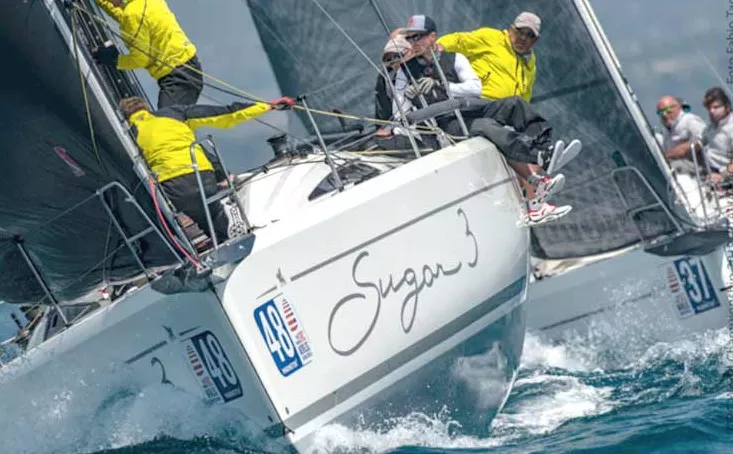Sailing short-handed—crewing a yacht with minimal personnel—has grown in popularity, offering both challenges and rewards. Designing yachts for such endeavors requires a focus on ease of handling, safety, and performance. Here, we explore eight outstanding yachts tailored for short-handed racing.
8 Best Short Handed Racing Yacht
1. J/105
Introduced in 1992, the J/105 revolutionized short-handed sailing. Its light displacement and large asymmetric spinnaker made downwind sailing exhilarating, with speeds reaching the mid-teens. The design’s simplicity and performance have cemented its status among sailors.
Specifications:
- Length Overall (LOA): 10.52 meters (34.5 feet)
- Beam: 3.35 meters (11 feet)
- Draft: 1.98 meters (6.5 feet)
- Displacement: 3,493 kilograms (7,700 pounds)
- Sail Area: 58.5 square meters (630 square feet)
Analysis:
The J/105’s design emphasizes ease of handling, making it ideal for short-handed crews. Its spacious cockpit and straightforward rigging allow for efficient sail management. The boat’s performance in various conditions has made it a favorite in both coastal and offshore races.
2. Jeanneau Sun Fast 3200
Designed for offshore racing, the Sun Fast 3200 has gained acclaim for its performance and handling. Conceived for the TransQuadra transatlantic race, it has achieved downwind speeds nearing 20 knots, even when steered by autopilot.
Specifications:
- LOA: 10.1 meters (33.1 feet)
- Beam: 3.48 meters (11.4 feet)
- Draft: 1.9 meters (6.2 feet)
- Displacement: 3,400 kilograms (7,496 pounds)
- Sail Area: 60 square meters (646 square feet)
Analysis:
The Sun Fast 3200’s twin-rudder design ensures control at high speeds, a crucial feature for short-handed crews. Its stability and responsiveness have led to numerous racing successes, solidifying its reputation in the sailing community.
3. JPK 10.80
The JPK 10.80 has established itself as a formidable competitor under the IRC rating rule. Notably, Géry Trentesaux’s Courrier Du Leon secured both the Rolex Fastnet Race overall and the Royal Ocean Racing Club season’s points in 2015.
Specifications:
- LOA: 10.8 meters (35.4 feet)
- Beam: 3.65 meters (12 feet)
- Draft: 2.2 meters (7.2 feet)
- Displacement: 4,500 kilograms (9,921 pounds)
- Sail Area: 70 square meters (753 square feet)
Analysis:
Optimized for both short-handed and fully crewed racing, the JPK 10.80 offers versatility and performance. Its design facilitates easy handling, making it a top choice for sailors seeking competitive edge in various racing formats.
4. J/11S
Sharing its hull with the J/111, the J/11S is tailored specifically for short-handed sailing. Modifications include twin rudders, a slightly shorter rig, and increased internal ballast, enhancing stability and control.
Specifications:
- LOA: 10.9 meters (35.8 feet)
- Beam: 3.31 meters (10.8 feet)
- Draft: 2.99 meters (9.8 feet)
- Displacement: 4,600 kilograms (10,141 pounds)
- Sail Area (Upwind): 63 square meters (678 square feet)
Analysis:
The J/11S’s design modifications cater to the unique demands of short-handed sailing. Its balanced helm and responsive handling make it a joy to sail, while the option for both asymmetric and symmetric spinnakers adds versatility.
5. J/99
The J/99 is designed for short-handed offshore racing, offering a balance between performance and comfort. Its hull shape and sail plan are optimized for easy handling and speed.
Specifications:
- LOA: 9.9 meters (32.6 feet)
- Beam: 3.4 meters (11.2 feet)
- Draft: 1.9 meters (6.2 feet)
- Displacement: 3,800 kilograms (8,377 pounds)
- Sail Area: 66 square meters (710 square feet)
Analysis:
The J/99’s design emphasizes simplicity and efficiency, crucial for short-handed crews. Its ergonomic cockpit and straightforward rigging allow for effective sail management, making it a competitive choice for offshore racing.
6. Figaro Bénéteau 3
The Figaro Bénéteau 3 is the first production monohull equipped with hydrofoils, marking a significant advancement in yacht design. Introduced in 2017, it was specifically designed for the Solitaire du Figaro race.
Specifications:
- LOA: 10.85 meters (35.6 feet)
- Beam: 3.47 meters (11.4 feet)
- Draft: 2.5 meters (8.2 feet)
- Displacement: 3,175 kilograms (7,000 pounds)
- Sail Area (Upwind): 70 square meters (753 square feet)
- Sail Area (Downwind): 144 square meters (1,550 square feet)
Analysis:
The Figaro Bénéteau 3’s hydrofoils are designed to reduce leeway and improve righting moment without increasing displacement. This innovation enhances performance, especially in downwind conditions. The yacht’s design eliminates the need for ballast tanks, simplifying operation for short-handed sailors. Its advanced features have set new standards in offshore racing.
7. Pogo 12.50
The Pogo 12.50 is renowned for its speed and ease of handling, making it a popular choice among short-handed sailors. Its design focuses on performance without compromising comfort.
Specifications:
- LOA: 12.18 meters (39.9 feet)
- Beam: 4.5 meters (14.8 feet)
- Draft: 3.0 meters (9.8 feet)
- Displacement: 5,500 kilograms (12,125 pounds)
- Sail Area (Upwind): 115 square meters (1,238 square feet)
Analysis:
The Pogo 12.50’s wide beam and flat hull design contribute to its stability and planing capabilities. Its twin rudders provide excellent control, even at high speeds. The yacht’s layout and sail plan are optimized for short-handed sailing, ensuring both performance and safety.
8. Class 40
The Class 40 is a versatile racing yacht designed for both short-handed and fully crewed offshore racing. Its design adheres to a box rule, ensuring affordability and competitiveness.
Specifications:
- LOA: 12.19 meters (40 feet)
- Beam: 4.5 meters (14.8 feet)
- Draft: 3.0 meters (9.8 feet)
- Displacement: 4,500 to 5,000 kilograms (9,921 to 11,023 pounds)
- Sail Area (Upwind): 100 square meters (1,076 square feet)
Analysis:
The Class 40’s design emphasizes simplicity and robustness, making it suitable for various offshore races. Its spacious cockpit and deck layout facilitate easy handling by short-handed crews. The class’s strict regulations ensure close competition, highlighting sailors’ skills.
Conclusion
Short-handed racing demands yachts that are not only fast but also manageable with minimal crew. The eight yachts discussed above exemplify these qualities, each offering unique features tailored to the challenges of short-handed sailing. From the pioneering hydrofoils of the Figaro Bénéteau 3 to the versatile design of the Class 40, these yachts provide sailors with the tools to compete effectively and safely in offshore races.

